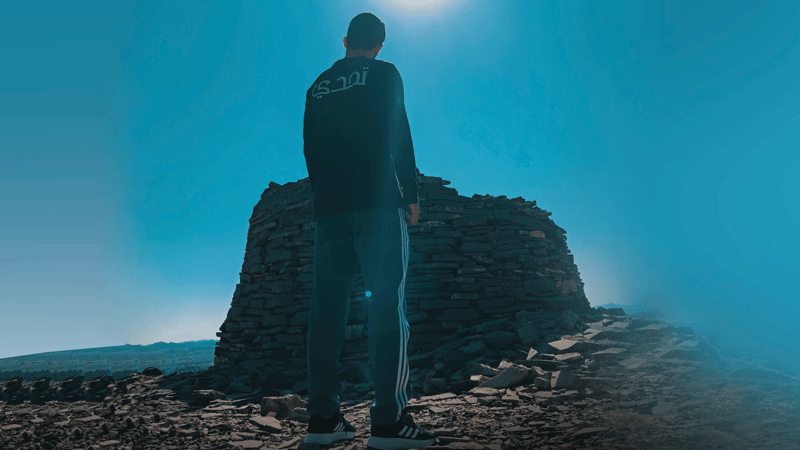


He noticed them from afar — an anomaly in a landscape of barren mountains. He thought they were old houses but were far too many and spread across the top of mountains that it doesn’t connect well with how villages in Oman are built.
It piqued his interest that one weekend, he decided to check them out.
He lives in Manah and Izki is but a few minutes away from his home. It was only upon closer inspection that he discovered what they were — dozens of beehive tombs that were about 3000 years old.
It was a surprise for Almutasim al Mahmoodi to discover that such beehive tombs and more than three dozens of them also exist in this area. He is aware of the beehive tombs in the more popular and Unesco heritage sites of al-Ain and Bat but for them to spread over to Zukait — the small farming village dominated by well-maintained farms, it was a discovery he said was both good and sad news.
Needed repairs

The beehive tombs of Zukait in the Wilayat of Izki has seen better days. In fact, in the middle of the 2000s, efforts were made to build interest in the tombs and turn them into a tourist attraction.
In some videos buried in the archives of Youtube, hundreds of travellers used to flock in the area as these tombs are more accessible than the ones found in Bat and al-Ain.
Today, however, residents reported that the tombs is lucky to even get visited at least twice a week.
At the entrance of the site was a coffee shop, now abandoned with most of the concrete stairs leading to the top in some form of disarray.
A welcome mark stone gives a brief background about the area: that Archaeological excavations in Oman provide evidence of its rich past with diverse civilisations whose cultures mixed together from as early as 3000 BC; that the Zukait tombs, located atop the hills overlooking the eponymous village, is a testament to the richness of the bygone era; and that these tombs were an indication of the expansion of Oman’s civilisations over time.

Like the ones found in Bat and Al- Ain, the ancient tombs of Zukait also take a beehive-form built by using flat stones put on top of each other. There is a small hole on the front side that served as its entrance.
Government effort to protect the tomb is still evident through the fence built surrounding some of the tombs. While some are still standing, others have crumbled to the ground that only the base remains.
“I’m noticing that not a lot of the Omani youth are interested in archaeological discoveries in the country. It’s a bit disappointing as we have one of the most historic countries in the world and we can actually see history before our eyes’’, Al Mahmoodi said.
Different studies were already made in the area. Relevant Oman authorities have worked with different experts in the archaeological field from other countries to discover the extent of Oman’s growth over the years.
In a preliminary report made by Juergen Schreiber of German Archaeological Institute, Orient Department in Berlin, he noted “In every respect, Izki is an important place in Omani history. So is Izki the only place in Oman, which is mentioned in sources of the neo-Assyrian period. According to an inscription of the so-called “Ishtar-slab” in Ninive (c. 640 BC), a king named Padê came from a land called Qadê after half a year’s journey to the royal court of Ninive, to pay tribute to Ashurbanipal, King of Assyria. The name of Padê´s town can be transcribed as Is/1/z–ki/qi-e, which fits very well with the modern name Izki.”
Even then, Schreiber observed that the tombs all “appear to be heavily disturbed and normally just the lowest stone layer is preserved” with an average dimension of 5 x 3 metres. His initial report puts the date in the Late Iron Age and noted that the tradition using the same sites as burial places.
For Schreiber and his colleagues, “Zukait is a vast necropolis of beehive-tombs” together with those in Hafit tomb and other nearby areas, “All in all there must have been hundreds of them.”

Renewing interest on the site
For Al Mahmoodi, he said that putting more effort to promote the Izki/Zukait tomb would also help create footfall in the area.
He said that other than the tombs, Zukait has amazing forts and ruins that although smaller than those found in other villages or wilayats, are still as historic and beautiful.
“One of the local towers is still being used today. From the top, you can see the rest of the village and you will also have a good vantage view of the tomb from the hills’’, he said.
Mostly a farming village, Zukait has but a few commercial centres with most of the residents buying their supplies from Nizwa and other bigger towns.
They also have a good falaj system that supplies ample water to the many farms in the area.
“My worry is that the tombs will be vandalised as I can see some damages in many of them. Oman’s heritage is only as good as the effort we put into preserving them’’, he said.
BY YERU EBUEN
Oman Observer is now on the WhatsApp channel. Click here



